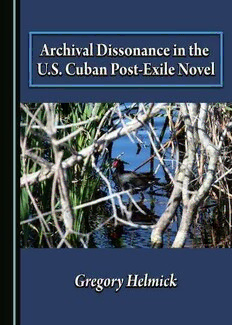Table Of ContentArchival Dissonance
in the U.S. Cuban
Post-Exile Novel
Archival Dissonance
in the U.S. Cuban
Post-Exile Novel
By
Gregory Helmick
Archival Dissonance in the U.S. Cuban Post-Exile Novel
By Gregory Helmick
This book first published 2016
Cambridge Scholars Publishing
Lady Stephenson Library, Newcastle upon Tyne, NE6 2PA, UK
British Library Cataloguing in Publication Data
A catalogue record for this book is available from the British Library
Copyright © 2016 by Gregory Helmick
All rights for this book reserved. No part of this book may be reproduced,
stored in a retrieval system, or transmitted, in any form or by any means,
electronic, mechanical, photocopying, recording or otherwise, without
the prior permission of the copyright owner.
ISBN (10): 1-4438-8545-2
ISBN (13): 978-1-4438-8545-4
For Joanna, Sam, and James
In some century to come, when the school children will whistle popular
tunes in quarter-tones—when the diatonic scale will be as obsolete as the
pentatonic is now—perhaps then these borderland experiences may be both
easily expressed and readily recognized. (Charles Ives, Essays Before a
Sonata71)
TABLE OF CONTENTS
ACKNOWLEDGEMENTS ................................................................................ ix
CHAPTER ONE ............................................................................................... 1
Introduction: Archival Dissonance as Metacritical Methodology
in the U.S. Cuban Post-Exile Novel
Outliers of the Ethnic Paradigm in U.S. Cuban Fiction
From Exile to “Post-Exile” in the U.S. Cuban Historical Novel
Historiography in the Development of U.S. Cuban Literature
Plan of the Book
CHAPTER TWO ............................................................................................ 23
Cuban Revisionist Historiography and Transculturation
in Roberto G. Fernández’s La vida es un special$1.50.75
Readership and Reception of Fernández’s Novels
Vignette Structures in La vida es un special
Fernández’s Novels as Metacritical Archive
Dystopian Florida Cuban Fiction and its Contexts
Empire and Sugar Aristocracy
Transcultured Thanksgiving Myths, Pattaki of “San Given”
Re-archiving Operation Pedro Pan and the Mariel Exodus
Black Friday: Cuban American Politics, Florida Sugar, and Military
Occupation
Reconstituted Aristocracies
“We All Live In a Yellow Submarine”: Rhetorical Validation
of Revolution in La vida es un special and the Areíto Group
Criticism of Cuban Exile Literature in Fernández’s Work
Discourse, Historicity, and Bargain Shopping: Critical Parody
of Lilayando in La vida es un special
Documenting the Occult: Santería as Archive and the Esu, Griñán
Peralta, and Sarduy Subtexts in La vida es un special
Synthesis: Sugar People, Transcultured Turkeys, and Archival Ghosts
viii Table of Contents
CHAPTER THREE ......................................................................................... 81
Commodifying Revolution as Popular Romance in Loving Che
by Ana Menéndez
Menéndez’s Career, Readership, and Reception
Towards Loving Che and After
Menéndez and the Miami Media Machine
Overview and Context of the Novel: Gendered Discourse of Family
and Nation
Interposition of the Cuban Exile Grandfather
Markings of Cuba’s Special Period in Loving Che
Interposition of Apocryphal Revolutionary History as Romance Fiction
Reader Response and the Popular Romance Frame
“Great Man” Historiography in Loving Che
Historical and Literary Sources for Guevara and the Cuban Revolution
in Loving Che
Martí, Intertextuality, and Monumentality in Loving Che
Conclusions
CHAPTER FOUR ......................................................................................... 135
Staging Enriqueta Faber as Post-Exile,Transatlantic, Trans-Caribbean
Memoirist in Mujer en traje de batalla by Antonio Benítez Rojo
Antonio Benítez Rojo: Statistics and Literature, 1958-2005
Benítez Rojo’s Caribbean Trilogy, 1979-2000
Mujer en traje de batalla: Overview and Critical Reception
Cuban Archival Appropriation of Enriqueta Faber as Paratextual Frame
in Mujer en traje de batalla: From Calcagno to Marrero
“Éste, que ves, engaño colorido”: Specular Transvestitism in Mujer
en traje de batalla
“Caos se ha visto en la historia de la humanidad”:
Henriette Faber-Cavent’s Memoir
Oceanic Textualities of Maryse Polidor: Improvisation
and Supersyncretism as a Poetics of Survival and Trans-
Caribbean Plantation History
The Island of Juana de León
Conclusion: The Progression of Enriqueta Faber’s Last Archival
Meditations
CONCLUSIONS ........................................................................................... 193
NOTES ....................................................................................................... 199
WORKSCITED ........................................................................................... 215
ACKNOWLEDGMENTS
I wish to gratefully acknowledge César A. Salgado, Jossianna Arroyo-
Martínez, Naomi E. Lindstrom, Nicolas Shumway, and Harold A. Wylie,
Jr., who made this project possible from its origins at the University of
Texas at Austin. I also owe a note of appreciation to Jorge Febles, Roberto
G. Fernández, Ana Menéndez, and Gustavo Pérez Firmat for having taken
the time to discuss it with me at different stages. Finally, many sincere
thanks to my colleagues and friends at the University of North Florida for
their generous support and insight.

